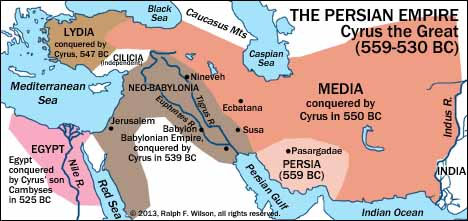Septuagint Isaiah 47: Metaphor and Symbol
God through the prophet continues to speak in Isaiah 47. He uses metaphor throughout to describe the downfall in judgment of the city of Babylon. The historical city of Babylon is the site of Israel’s captivity. It was the center of power of the Chaldean Empire during the sixth and fifth centuries BCE. Nebuchadnezzar was the Babylonian ruler who conquered Israel and led them captive (2 Kings 24-25).

Effects of Metaphor
The use of metaphor in language creates meaning on several levels. Metaphor presents a subject as a picture, or image, of something quite unrelated. For example, a city is not a female person (Isaiah 47:1) Cities don’t wear a dress to wade across a river (Isaiah 47:2). Neither do cities speak (Isaiah 47:8). All the images God uses to describe Babylon are of people. Personification is the word for assigning people-like qualities to nonliving objects and abstract ideas.
People have personalities, character, and soul. People perform good and evil. They also have a will. People think and talk. A city, on the other hand, is not a human being with a will to achieve either good or evil. Cities don’t have mouths that speak. In a certain sense, the description of the wicked woman God presents symbolizes the historical city of Babylon. On a concrete-literal level, Cyrus the Persian fulfilled this prophecy when he conquered Babylon in 539 BCE.
Nevertheless, God chose metaphorical terms. If God had chosen to prophesy against the historical city in strictly concrete terms, as a journalist might, the effect would have been quite different. A strictly concrete-literal prophecy would have a limited, local only application. That is, the fulfillment of the prophecy would be confined to one particular city at a definite point in time. But as it is, the metaphorical prophecy against Babylon in Isaiah 47 yields meaning at multiple levels.
Multiple Levels of Meaning
What are the multiple levels of meaning in Isaiah 47?
First, of course, is the concrete-literal. As previously noted, the historical fulfillment of God’s prophecy against Babylon occurred in 539 BCE.
Second are the symbolic meanings.
- First, Babylon can symbolize the wickedness of all large cities which become centers of power. Living in a large city often causes greatly cruel circumstances to befall people without resources. People suffer in big cities. Events and conditions trample people to death.
- Second, Babylon can symbolize systems of economy, commerce, and government that show little mercy for powerless people.
- Next, Babylon can symbolize a being. That being could be Satan.
- Finally, Babylon could symbolize evil itself, as a quality.
Babylon Symbolic of Satan
What contextual support is there for thinking that Babylon in Septuagint Isaiah 47 might symbolize Satan?
NARROW CONTEXT
The narrowest context is Septuagint Isaiah 47 itself.
God most likely chose Babylon the city to represent the empire of Babylon, as the seat of its power. He also chose to represent this power as an individual person, to whom he gave a speaking role. The fact that the person of Babylon is a woman, does seem to work against its symbolizing Satan. Demons, however, are not sexual beings with gendered bodies.
Why Satan? As a wicked individual, Satan is the most prominent in Scripture. He is the one most frequently named.
1. Babylon’s “I am… “
As noted previously, cities don’t speak. This city, however, says “I am… ” three times in the Septuagint (verse 8, and twice in verse 10).
10 … for you said, I am, and there is not another: know you, the understanding of these things and your harlotry shall be your shame; for you said in your heart, I am, and there is not another. (LXE)
The “I am” phrase is God’s own special name for himself. God names himself this way throughout all Scripture. God first revealed himself to Moses as “I am… ”
Exodus 3:13 And Moses said to God, Behold, I shall go forth to the children of Israel, and shall say to them, The God of our fathers has sent me to you; and they will ask me, What is his name? What shall I say to them? 14 And God spoke to Moses, saying, I am THE BEING; and he said, Thus shall you say to the children of Israel, THE BEING has sent me to you. 15 And God said again to Moses, Thus shall you say to the sons of Israel, The Lord God of our fathers, the God of Abraam, and God of Isaac, and God of Jacob, has sent me to you: this is my name for ever, and my memorial to generations of generations. (LXE)
The height of blasphemy is to refer to oneself by using God’s own personal, special name. By saying this, the character whom Babylon symbolizes (most likely Satan) claims to be God. This places him in competitive opposition to God, that is, as God’s enemy. And God’s primary enemy is indeed Satan.
Isaiah 14:12 How has Lucifer, that rose in the morning, fallen from heaven! He that sent orders to all the nations is crushed to the earth. 13 But you said in your heart, I will go up to heaven, I will set my throne above the stars of heaven: I will sit on a lofty mount, on the lofty mountains toward the north: 14 I will go up above the clouds: I will be like the Most High. 15 But now you shall go down to hell, even to the foundations of the earth. (LXE)
2. Babylon’s Character
The character of the woman who symbolizes both the city Babylon and the being Satan, manifests herself through actions opposite to those of God. This being “profaned my inheritance” and “showed them no mercy” (verse 6). The metaphorical woman performed “enchantments” and “a multitude of … sorceries” (verse 12). The final end of this symbolic character will be “destruction” (verse 11) and “no salvation” (verses 11 and 15).
BROADER CONTEXT
Babylon as Counterpoint to the Righteous Man
One of the major purposes of Isaiah is to present Messiah. Messiah is characterized by righteousness (Isaiah 11:4, 5; 16:5; 24:16; 33:5; and 42:6). Isaiah portrays Cyrus as a type of Messiah, one who acts in righteousness (Isaiah 45:13 and 46:10-13). In Isaiah, Cyrus defeats Babylon. This represents Christ in the New Testament defeating Satan.
BROADEST CONTEXT
The Bible as a Whole
The broadest possible biblical context in which to consider the symbolism of Babylon in Isaiah 47 is the entire Bible. The basic storyline of the Bible from Genesis 1 to Revelation 22 is to show how God defeats his arch enemy Satan. In this story, God expresses his nature of love by creating humanity to reflect himself. Satan, unable to attack and kill God directly, attempts to do so by destroying the object of God’s love, that is, God’s people. God sends his Son Messiah to save his people. Messiah and Satan fight against each other. Messiah destroys Satan and his works, just as Cyrus in Isaiah opposes and destroys Babylon and her works. In the grand biblical story, Israel is like the battlefield where the great battle of the ages occurs.
Looking Ahead
Chapter 48 continues the symbolism Isaiah introduces in chapter 47. In God’s camp are two kinds of people. There are those who stubbornly refuse God, and there are those who respond positively. God addresses both these groups. Septuagint Isaiah 48:20 sounds the rallying cry for this chapter.
Go out from Babylon, fleeing from the Chaldeans; proclaim a voice of joy, and let this be heard; report it to the end of the earth; say, “The Lord has delivered his slave Iakob!” (NETS )
